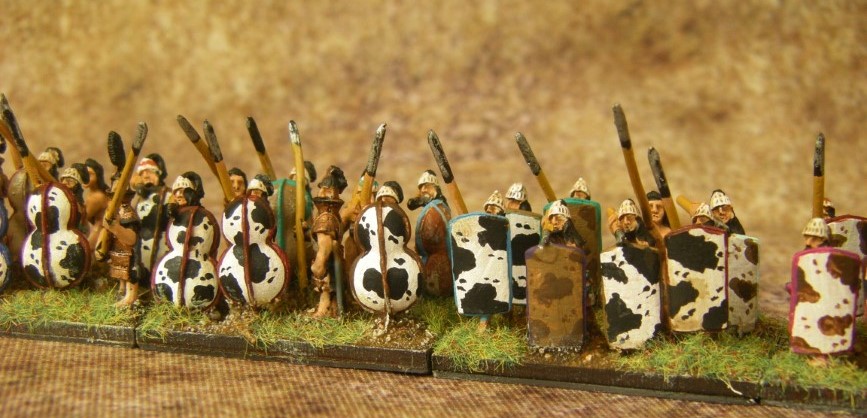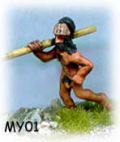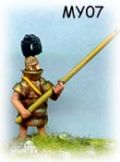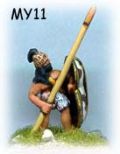Historical Overview Section

Mycenaean Greece (1600 BC -1100 BC) was a cultural period of Ancient Greece taking its name from the archaeological site of Mycenae in northeastern Argolis, in the Peloponnese of southern Greece. Athens, Pylos, Thebes, and Tiryns are also important Mycenaean sites. The last phase of the Bronze Age in Ancient Greece, it is the historical setting of much ancient Greek literature and myth, including the epics of Homer. Around 1400 BC (when this list kinda starts) the Mycenaeans extended their control to Crete, center of the Later Minoan or Early Mycenean? Minoan civilization, and adopted a form of the Minoan script (called Linear A) to write their early form of Greek in Linear B.
Not only did the Mycenaeans defeat the Minoans, but according to later Hellenic legend they defeated Troy, presented in epic as a city-state that rivaled Mycenae in power. Because the only evidence for the conquests is Homer's Iliad and other texts steeped in mythology, the existence of Troy and the historicity of the Trojan War is uncertain.
Mycenaean civilization was dominated by a warrior aristocracy and many military items have been found by archeologists. The most impressive work is that of the Dendra panoply, a complete suit of Mycenaean armor. The cuirass is made up of bronze plates sewn to a leather garment. The weight of this armor must have hindered the mobility of a warrior, and it is for this reason it is supposed that it was worn by a warrior riding in a chariot. The typical Mycenaean helmet, in use from the seventeenth to the tenth centuries BC, was made of cut segments of boar's tusk sewn to a leather or cloth backing and is illustrated in ivory relief plaques found in the shaft graves of the seventeenth and sixteenth centuries BC and in wall paintings of that era from Akrotiri on Thera (Santorini) and of the thirteenth century BC in the so-called Palace of Nestor at Pylos. Groups of boar's tusk plates from the helmets themselves have been found at many sites, including Mycenae, Prosymna, Thermon and Elateia, as well as in southern Italy. This is the type of helmet which is described by Homer several hundred years later. Two types of shields were used: the "figure eight" or "fiddle" shield, and a rectangular type, the "tower" shield, rounded on the top. They were made of wood and leather, and were of such a large size that a warrior could completely cower behind his shield. Offensive arms were made of bronze. Spears and javelins have been found, and also an assortment of swords of different sizes designed for striking with the point and with the edge. Daggers and arrows, attesting to the existence of archery, compose the remainder of the armament found from this period.
Several explanations have been advanced for the causes of the decline of Mycenaean civilization including natural factors (climate change, earthquakes), however the most common theories are population movement and internal conflict, with the role of invaders such as the Dorian Greeks or the Sea Peoples? complicit in both.
Troy
Ancient Greek historians placed the Trojan War variously in the 12th, 13th, or 14th century BCE: Eratosthenes to 1184 BCE, Herodotus to 1250 BCE, Duris of Samos to 1334 BCE. In the Iliad, the Achaeans set up their camp near the mouth of the river Scamander where they had beached their ships. The city of Troy itself stood on a hill, across the plain of Scamander, where the battles of the Trojan War took place. Recent geological findings have permitted the reconstruction of how the original Trojan coastline would have looked, and the results largely confirm the accuracy of the Homeric geography of Troy. Besides the Iliad, there are references to Troy in the other major work attributed to Homer, the Odyssey, as well as in other ancient Greek literature. The Homeric legend of Troy was elaborated by the Roman poet Virgil in his Aeneid. The Greeks and Romans took for a fact the historicity of the Trojan War and the identity of Homeric Troy with the site in Anatolia. Alexander the Great, for example, visited the site in 334 BCE and made sacrifices at tombs there associated with the Homeric heroes Achilles and Patroclus.
Using the army in ADLG
- Sadly the lack of Impact on the heavy Chariotry means this army often ends up being a little undergunned in period competitions, and certainly means the "lots of heavy chariots" options isn't as good as it looks at first glance
- Because the HCh are underpowered, perhaps a better tactic is trying to persuade enemy HCh to charge yur Spearmen - which, added to the presence of Impact Foot in many other popular biblical-era lists means this is one of the few armies where adding Rear Support is a good use of points, as it mitigates the desructive power of both of these types of opponents, allowing you to try and grind them down in subsequent rounds of combat.
- The units of bowmen may look like an oddity, but in theme many other armies have a lot of mixed formation shooters, and so your Myceneans can soon find they are being shot down a level or two before combat without their own bowmen and/or screening LF to protect them.
- These same bowmen also can also be used to help encourage/force enemy Charioty into charging your spearmen
- The Myrmidions are better than most other rough terrain troops, but do need some support - which quickly starts to eat into the army points total.
- Don't overlook the LCh option for the chariots - whilst they may not seem dangerous using massed LCh can allow you to both outnumber and overwhelm an enemy mounted wing, and then give you more than enough troops to turn that into an attack on the centre's flank.
- If using LCh don't close the table down too much, rough terrain is your friend as you have enough options to outclass most other medium infantry and wide pen spaces will help your chariots out considerably.
Useful Links
User-contributed links about this army. Add links in this format:
- Myceneans - a full army painted of Museum figures.
as an example
- Arab Conquest Arab Conquest army on Fanaticus
15mm Manufacturers supplying figures for this army
You can see some of the figures in the Ancients Photo Gallery also on this site
|
|
|

|

|

|
- Essex Miniatures Minoan, Mycenean and Trojan war ranges
- Black Hat Gladiator Games beefy Trojan/Mycenean Range.
- Old Glory Good Mycenean/Minoan range
- Magister Militum (includes former Chariot ranges) - Biblical is their specialist period. Minoan range can be used
- Museum - Dendra armour and everything for these guys - a really nice range
- Baueda They sell some buildings for the era!
- MY Miniatures - Trojan range
Army Lists
Sample army lists for this army:
2nd place at Warfare 2022
Nestor - Ordinary Unreliable
4 Nestors Pylian Spearmen Heavy Spearmen Support
1 Chariots Light Chariot Javelin
2 Bowmen Bowmen
1 Light Infantry Light Infantry Javelin
1 Light Infantry Light Infantry Sling
==
Achilles Ordinary Included
3 Spearmen Heavy Spearmen ------
2 Bowmen Bowmen ------
2 Achilles Myrmidions Medium swordsmen armour impact Elite
1 Spearmen Heavy Spearmen Pavise ------
1 Light Infantry Light Infantry Sling ----
1 Light Infantry Light Infantry Javelin ----
==
CinC Steve Ordinary
3 Spearmen Heavy Spearmen
2 Bowmen Bowmen
1 Chariots Light Chariot Javelin
2 Light Infantry Light Infantry Javelin
1 Spearmen Heavy Spearmen Pavise
This was essentially a "Wrestle a Pig" army due to its size and resilience compared to many Biblical armies, with 90 hit points to chew through.
The Chariots IMHO are too expensive and are still underpowered when it comes to meeting enemy HCh Impact Elite (which they will) so I minimized them and used only 2 cheap basic ones as mobile reserves to fill gaps when the line of spear and bow suffered breakthroughs. The 2 bowmen + a slinger in support can put out just enough firepower to damage enemy chariots, cavalry, and even Impact Swordsmen such that the Spearmen can absorb the initial assault and then get into a battle of attrition which they should prevail in - as they say, you should never wrestle a pig, as you'll both end up covered in sh+t but the pig will enjoy it!
4th place Avignon 2019
- 5 HI Spear Support
- 2 Bowmen
- 2 LF Javelin
Ordinary general
==
- 2 MF Spearmen
- 2 Armoured Impact MF Elite
- 2 LF Javelin
Ordinary Included
==
- 5 HI Spear Support
- 2 Bowmen
- 2 LF Javelin
- HCh Ordinary
Competent General
————
200 Points, Northern League 2019
CinC Competent
- 4 Heavy Spearmen
- 2 Medium Spearmen
- 2 Light Infantry Javelin
- 1 Bowmen
- 2 Light Infantry Bow
Sub General Brilliant
- 8 Light Chariot
Sub General Competent
- 4 Light Chariot
- 1 Bowmen
- 2 Light Infantry Sling
- 2 Medium Swordsmen Impact Elite
—————
200 Points
- 3 of these
- 4 of these
- etc
- etc